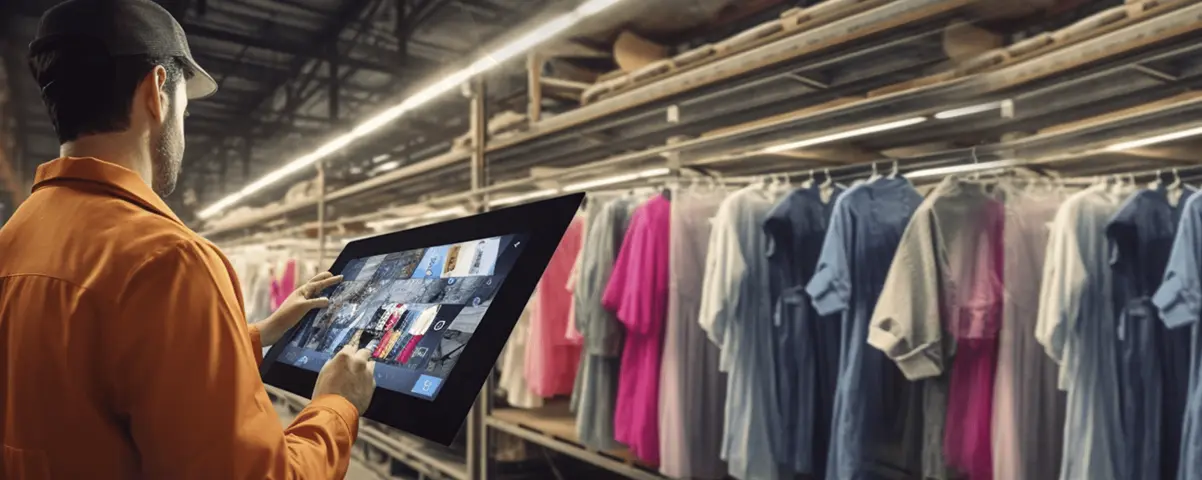Unleashing AI’s Potential in Apparel & Textiles: Beyond Automation
Introduction
What if I told you that the key to unlocking the full potential of artificial intelligence (AI) in the apparel and textile manufacturing industry lies not in automation alone, but in a deeper understanding of the technology and its myriad applications? Intrigued?
Read on to find out how AI can revolutionize every aspect of the apparel and textile manufacturing process, and how to make the most of your AI investments.
The concept of artificial intelligence has been around for decades, but its implementation in the manufacturing industry has gained significant momentum in recent years. As companies strive to stay competitive and meet the ever-growing demands of consumers, AI-driven automation has become a game-changer. It is quickly transforming the way market leading companies design, produce, and manage resources, while simultaneously improving efficiency and reducing costs. However, despite these advancements, many businesses are still struggling to harness the full potential of AI in their operations.
This article aims to address the confusion surrounding AI implementations and explore the untapped opportunities that lie beyond automation. We will delve into the various aspects of AI in apparel and textile manufacturing, such as its use in design, pattern making and sampling; smart manufacturing; quality control; predictive maintenance; optimum resource utilization; and inventory management.
Top 7 Applications of AI in Textile and Garment Manufacturing
Let’s examine how AI can revolutionize each of the abovementioned production processes, backed by relevant data and real-world examples:
1. Generative Design
The integration of AI in the design process has led to the emergence of generative design, a technique that utilizes machine learning algorithms to generate multiple design iterations based on specific input parameters. This not only accelerates the design process but also enables designers to explore a broader range of possibilities.
AI can enable customization and personalization of designs on a large scale. Customers can now have garments tailored to their specific measurements and preferences, with AI algorithms ensuring that each piece is crafted to perfection.
2. Pattern Making and Sampling
In the realm of pattern making and sampling, AI-powered software has transformed the way patterns are created and tested. By automating repetitive tasks and leveraging data-driven insights, these tools can significantly reduce human error and improve the overall accuracy of pattern making.
In fact, leading Computer Aided Design (CAD) software providers have developed advanced pattern making software that uses AI to optimize fabric utilization and generate precise patterns, resulting in reduced material waste and improved efficiency.
3. Digital Fashion Factories
Smart manufacturing, enabled by AI, has the potential to revolutionize the entire production process. Smart factories that incorporate AI-driven technologies such as robotics, computer vision, and machine learning can allow manufacturers to optimize production workflows, enhance quality control, and minimize downtime.
In some places, AI-powered robots and machines have started to replace traditional labor-intensive tasks. These advanced systems can work around the clock, significantly enhancing productivity and reducing waste. With AI’s ability to learn and improve over time, smart manufacturing is becoming more efficient and precise, resulting in higher quality products.
One interesting example which was possibly too ahead of its time was Adidas’ Speedfactory, a (now defunct) pilot project that utilizes AI-powered robots and 3D printing technology to produce customized footwear in record time.
4. Quality Control
Quality control and inspection is another critical area where AI can make a significant impact. Advanced inspection systems, powered by machine learning and computer vision, can detect defects and inconsistencies in real-time, ensuring that only high-quality products reach the end consumer.
AI algorithms can predict when a machine is likely to fail or require maintenance by analyzing data from sensors and historical maintenance records. This allows manufacturers to address potential issues before they become critical, minimizing downtime and increasing efficiency.
For example, the BMW Group harnesses automated image recognition to conduct quality checks and inspections, effectively eradicating pseudo-defects that deviate from target specifications without any actual faults. This implementation has enabled them to attain exceptional levels of manufacturing precision.
5. Predictive Machine Maintenance
Predictive maintenance, made possible by AI and data analytics, allows manufacturers to anticipate equipment failures and schedule maintenance proactively. This approach minimizes downtime, maximizes equipment life, and reduces overall maintenance costs.
A study by Deloitte revealed that predictive maintenance can reduce maintenance costs by 20–30% and increase equipment uptime by 10–20%.
6. Optimum Resource Utilization
AI plays a crucial role in optimizing enterprise resource management within the textile and garment industry. AI-powered demand forecasting tools can analyze historical sales data, market trends, and external factors to predict future demand with greater accuracy.
By analyzing production data and identifying patterns, AI algorithms can optimize energy consumption, reduce waste, and enhance overall operational efficiency.
For instance, Google used its DeepMind AI platform to optimize energy usage in its data centers, resulting in a 40% reduction in cooling costs.
7. Inventory Management
AI-driven inventory management systems can revolutionize the way businesses manage their supply chains. By leveraging machine learning algorithms to analyze historical sales data and predict future demand, these systems can help manufacturers avoid stockouts, reduce excess inventory, and optimize their production schedules.
One example of AI-powered inventory management in the fashion industry is the use of machine learning algorithms to analyze historical sales data, customer preferences, and trends to predict future demand and adjust inventory levels accordingly. Fast-fashion retailers like H&M and Zara use AI to optimize their supply chains and manage inventory more effectively
In conclusion, the potential of artificial intelligence in the apparel and textile manufacturing industry is vast and multifaceted. As we continue to explore the full potential of AI in this industry, the possibilities are truly endless but how can you make the most of it?
Maximizing Gains from AI Investments in the Apparel and Textile Manufacturing Industry

Having explored the potential of AI in the apparel and textile manufacturing industry, it is crucial to understand how businesses can maximize the gains from their AI investments. A study by Accenture found that companies that strategically invest in AI can boost their profitability by an average of 38%.
To maximize the ROI from AI investments, businesses should consider the following steps:
1. Identify the right use cases: Before investing in AI, companies should carefully evaluate their processes and identify areas where AI can deliver the most significant impact. This may include design, pattern making, manufacturing, quality control, or inventory management. By focusing on high-impact areas, businesses can ensure that their AI investments yield tangible results and drive positive change within the organization.
2. Leverage data: AI thrives on data. To optimize AI adoption, companies should invest in collecting, storing, and analyzing relevant data from their operations. This includes historical sales data, production data, and customer feedback, among others. By harnessing the power of data, businesses can train AI algorithms to make more accurate predictions, optimize processes, and uncover hidden insights that drive innovation.
3. Build internal capabilities: To fully capitalize on AI investments, businesses should develop internal capabilities to manage and maintain AI-driven technologies. This includes hiring and training employees in AI-related skills, such as machine learning, data analytics, and robotics. By fostering an AI-ready workforce, companies can ensure that they have the necessary expertise to implement, monitor, and optimize AI solutions.
4. Collaborate with experts: Given the complexity of AI technologies, businesses should consider partnering with external experts to accelerate their AI adoption. This may involve working with AI consultancies, research institutions, or technology vendors. By collaborating with experts, companies can access specialized knowledge and resources that can help them navigate the challenges of AI implementation and maximize their returns on investment.
5. Monitor and measure ROI: To ensure that AI investments are delivering the desired results, businesses should establish key performance indicators (KPIs) to track the progress and impact of AI initiatives. These KPIs may include metrics such as cost savings, productivity improvements, or customer satisfaction scores. By monitoring and measuring ROI, companies can make data-driven decisions about their AI investments and continuously optimize their AI-driven processes to yield maximum returns.
As we move forward, it is essential for companies to stay abreast of the latest developments in AI and adapt their strategies accordingly to remain competitive and thrive in the ever-evolving manufacturing sector.
Balancing Potential and Reality: Assessing AI’s Prospects and Limitations
The future of AI in the apparel and textile manufacturing industry is expected to be marked by continuous advancements in technology and increased adoption by businesses. As AI algorithms become more sophisticated, they will be able to tackle more complex tasks and provide even greater efficiencies in areas such as design, production, and supply chain management.
But despite AI’s promising future, it’s important to acknowledge some of the limitations and challenges that businesses may face when implementing AI technologies:
- Data privacy and security: As AI relies heavily on data, companies must ensure that they have robust data privacy and security measures in place to protect sensitive information and comply with relevant regulations.
- High initial investment: Implementing AI technologies can be expensive, particularly for small and medium-sized businesses. Companies must carefully consider the costs and potential returns on investment before embarking on AI-driven initiatives.
- Lack of skilled workforce: The adoption of AI technologies requires a skilled workforce trained in AI-related disciplines. Businesses may face challenges in finding and retaining talent with the necessary expertise to implement and manage AI solutions.
- Ethical considerations: The use of AI in the industry may raise ethical concerns, such as job displacement due to automation and potential biases in AI algorithms. Companies must address these concerns and ensure that their AI initiatives are aligned with ethical principles and guidelines.
Conclusion
The potential of AI to revolutionize the textile and garment manufacturing industry is undoubtedly immense. From streamlining design processes to enhancing manufacturing efficiency and optimizing supply chains, AI has the power to transform the way businesses operate and drive sustainable growth.
To fully harness the potential of AI, it is crucial for the industry to address the limitations and challenges mentioned earlier. This includes finding ways to reduce the initial investment costs, ensuring workforce adaptability, and maintaining data privacy and security. It is only by proactively addressing these issues that businesses will be able to create a solid foundation for the successful integration of AI and other technologies.
Embracing change and adopting new innovations is the key to sustainable and profitable growth in the textile and apparel manufacturing industry. If you want to digitally transform your apparel or textile business, speak to our fashion-tech experts!







